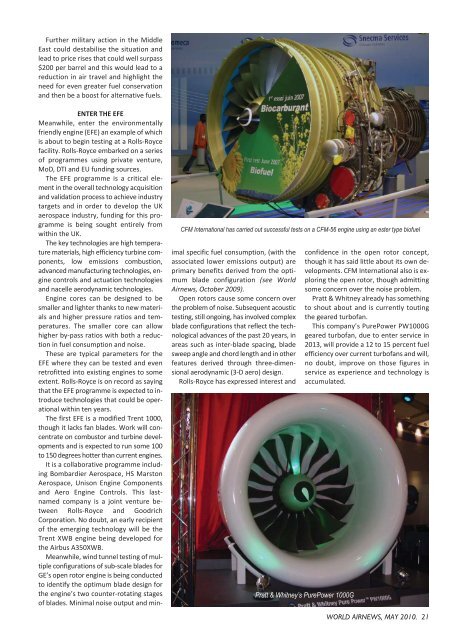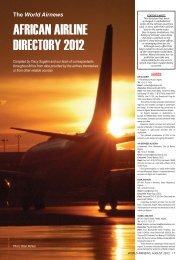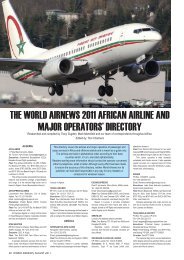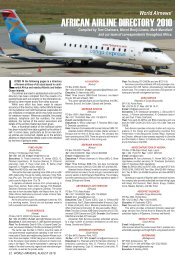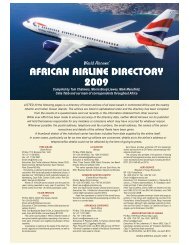May 2010 covers_Covers.qxd - World Airnews
May 2010 covers_Covers.qxd - World Airnews
May 2010 covers_Covers.qxd - World Airnews
You also want an ePaper? Increase the reach of your titles
YUMPU automatically turns print PDFs into web optimized ePapers that Google loves.
Further military action in the Middle<br />
East could destabilise the situation and<br />
lead to price rises that could well surpass<br />
$200 per barrel and this would lead to a<br />
reduction in air travel and highlight the<br />
need for even greater fuel conservation<br />
and then be a boost for alternative fuels.<br />
ENTER THE EFE<br />
Meanwhile, enter the environmentally<br />
friendly engine (EFE) an example of which<br />
is about to begin testing at a Rolls-Royce<br />
facility. Rolls-Royce embarked on a series<br />
of programmes using private venture,<br />
MoD, DTI and EU funding sources.<br />
The EFE programme is a critical element<br />
in the overall technology acquisition<br />
and validation process to achieve industry<br />
targets and in order to develop the UK<br />
aerospace industry, funding for this programme<br />
is being sought entirely from<br />
within the UK.<br />
The key technologies are high temperature<br />
materials, high efficiency turbine components,<br />
low emissions combustion,<br />
advanced manufacturing technologies, engine<br />
controls and actuation technologies<br />
and nacelle aerodynamic technologies.<br />
Engine cores can be designed to be<br />
smaller and lighter thanks to new materials<br />
and higher pressure ratios and temperatures.<br />
The smaller core can allow<br />
higher by-pass ratios with both a reduction<br />
in fuel consumption and noise.<br />
These are typical parameters for the<br />
EFE where they can be tested and even<br />
retrofitted into existing engines to some<br />
extent. Rolls-Royce is on record as saying<br />
that the EFE programme is expected to introduce<br />
technologies that could be operational<br />
within ten years.<br />
The first EFE is a modified Trent 1000,<br />
though it lacks fan blades. Work will concentrate<br />
on combustor and turbine developments<br />
and is expected to run some 100<br />
to 150 degrees hotter than current engines.<br />
It is a collaborative programme including<br />
Bombardier Aerospace, HS Marston<br />
Aerospace, Unison Engine Components<br />
and Aero Engine Controls. This lastnamed<br />
company is a joint venture between<br />
Rolls-Royce and Goodrich<br />
Corporation. No doubt, an early recipient<br />
of the emerging technology will be the<br />
Trent XWB engine being developed for<br />
the Airbus A350XWB.<br />
Meanwhile, wind tunnel testing of multiple<br />
configurations of sub-scale blades for<br />
GE’s open rotor engine is being conducted<br />
to identify the optimum blade design for<br />
the engine’s two counter-rotating stages<br />
of blades. Minimal noise output and min-<br />
CFM International has carried out successful tests on a CFM-56 engine using an ester type biofuel<br />
imal specific fuel consumption, (with the<br />
associated lower emissions output) are<br />
primary benefits derived from the optimum<br />
blade configuration (see <strong>World</strong><br />
<strong>Airnews</strong>, October 2009).<br />
Open rotors cause some concern over<br />
the problem of noise. Subsequent acoustic<br />
testing, still ongoing, has involved complex<br />
blade configurations that reflect the technological<br />
advances of the past 20 years, in<br />
areas such as inter-blade spacing, blade<br />
sweep angle and chord length and in other<br />
features derived through three-dimensional<br />
aerodynamic (3-D aero) design.<br />
Rolls-Royce has expressed interest and<br />
confidence in the open rotor concept,<br />
though it has said little about its own developments.<br />
CFM International also is exploring<br />
the open rotor, though admitting<br />
some concern over the noise problem.<br />
Pratt & Whitney already has something<br />
to shout about and is currently touting<br />
the geared turbofan.<br />
This company’s PurePower PW1000G<br />
geared turbofan, due to enter service in<br />
2013, will provide a 12 to 15 percent fuel<br />
efficiency over current turbofans and will,<br />
no doubt, improve on those figures in<br />
service as experience and technology is<br />
accumulated.<br />
Pratt & Whitney’s PurePower 1000G<br />
WORLD AIRNEWS, MAY <strong>2010</strong>. 21


